Answered step by step
Verified Expert Solution
Question
1 Approved Answer
Ecolab and the NALCO Acquisition: Sustainable Advantage Through Shared Values Assume the role of Doug Baker What a wonderful problem. Prepare a draft presentation for
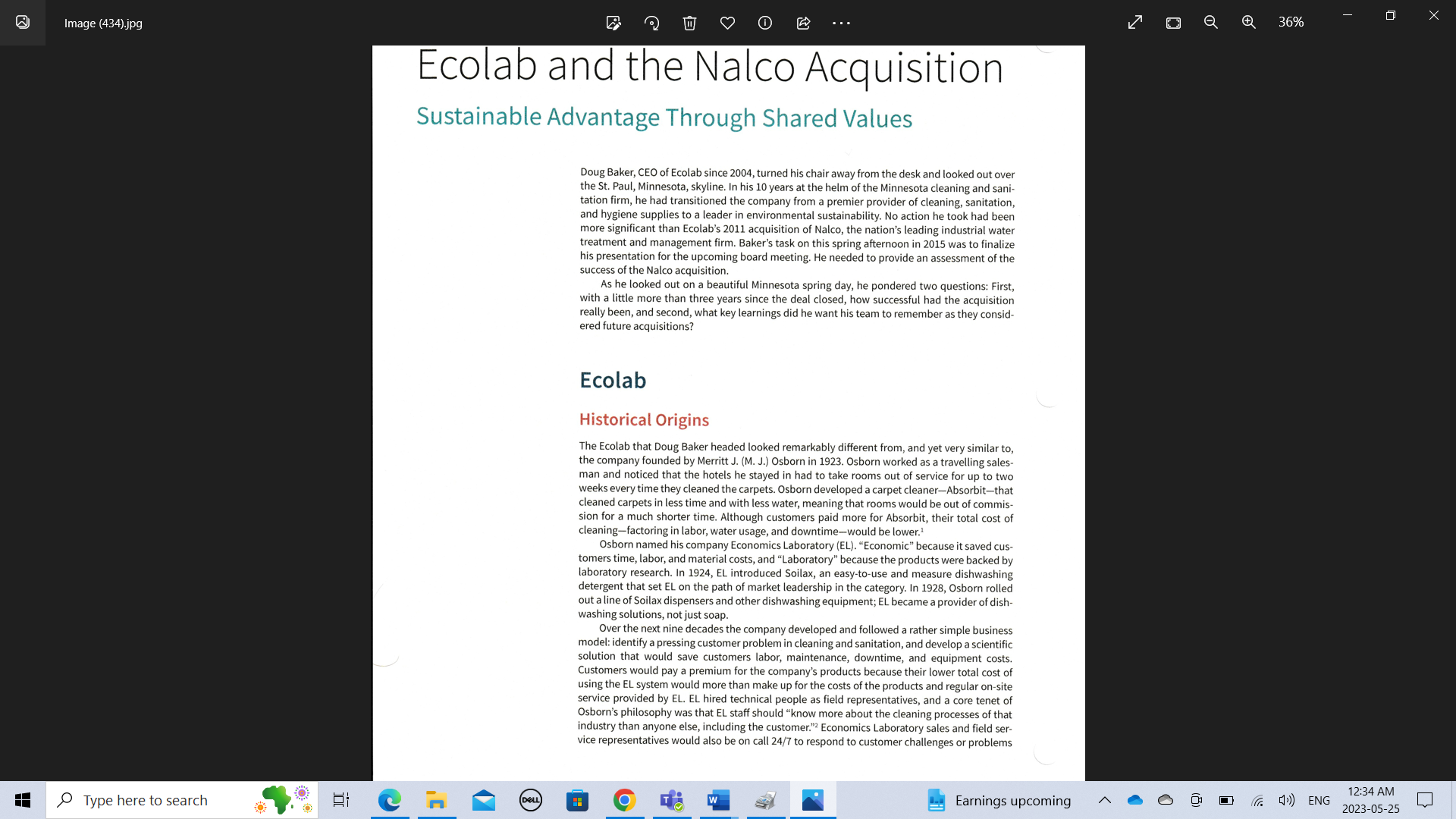
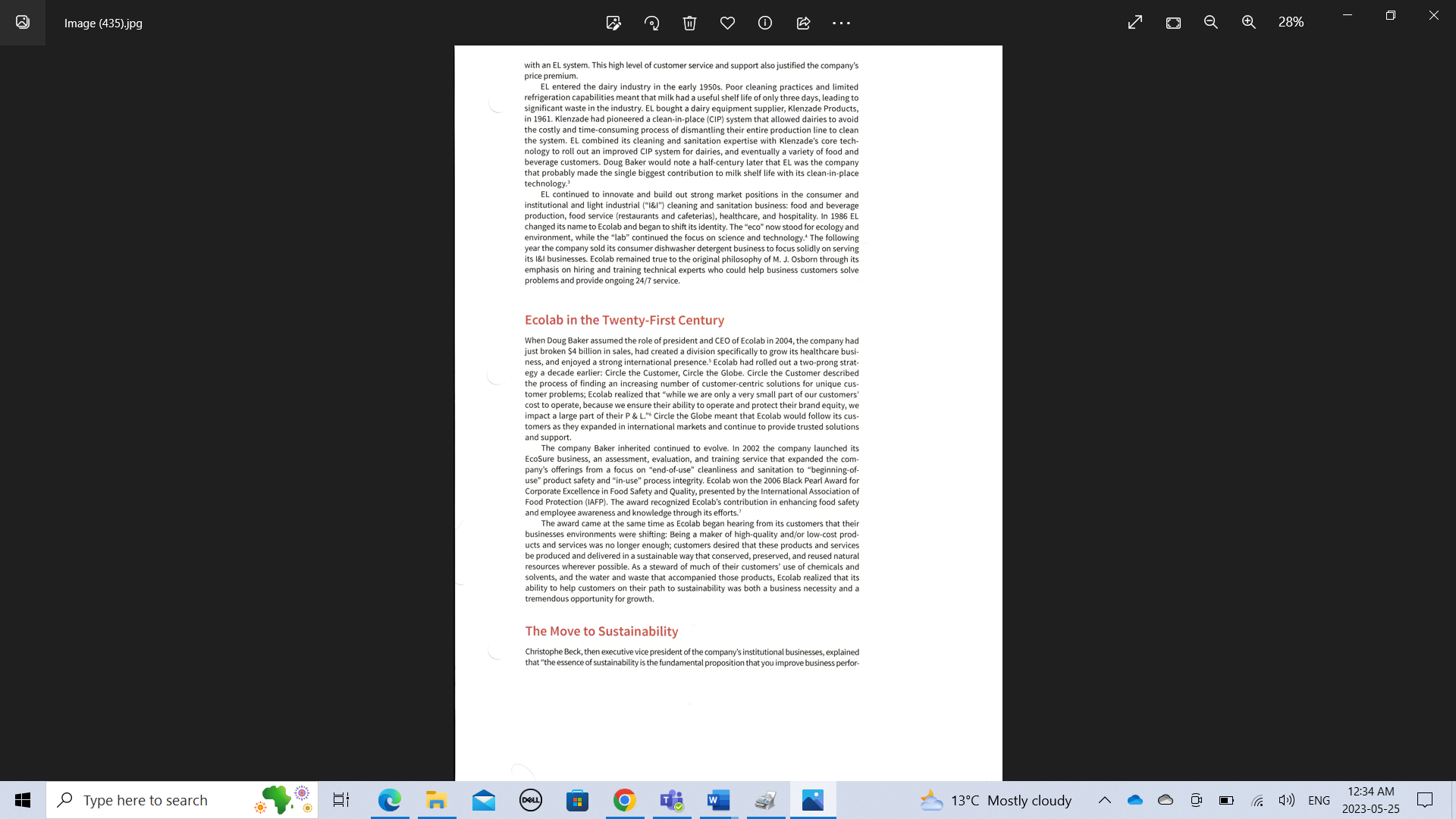
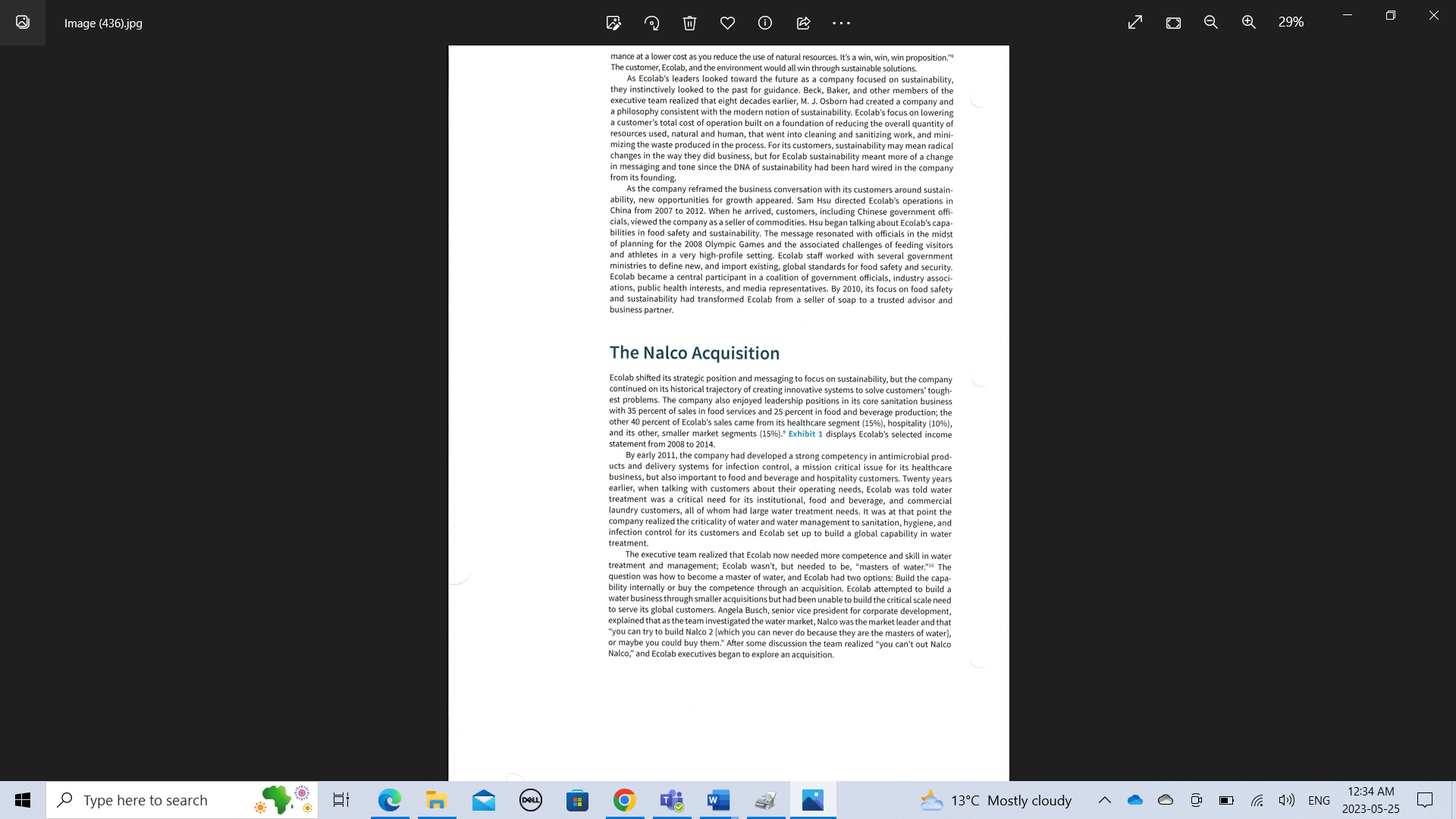
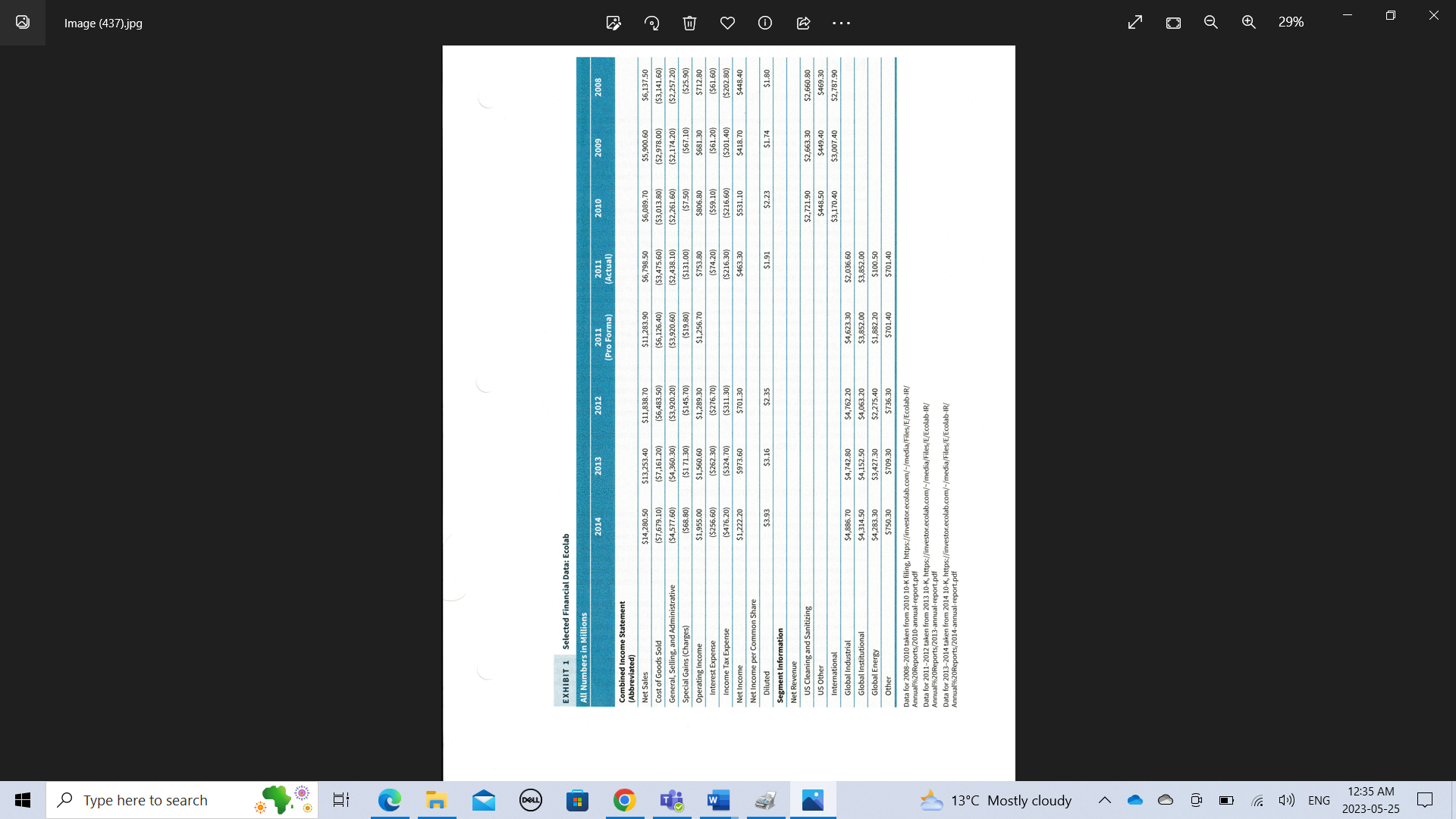
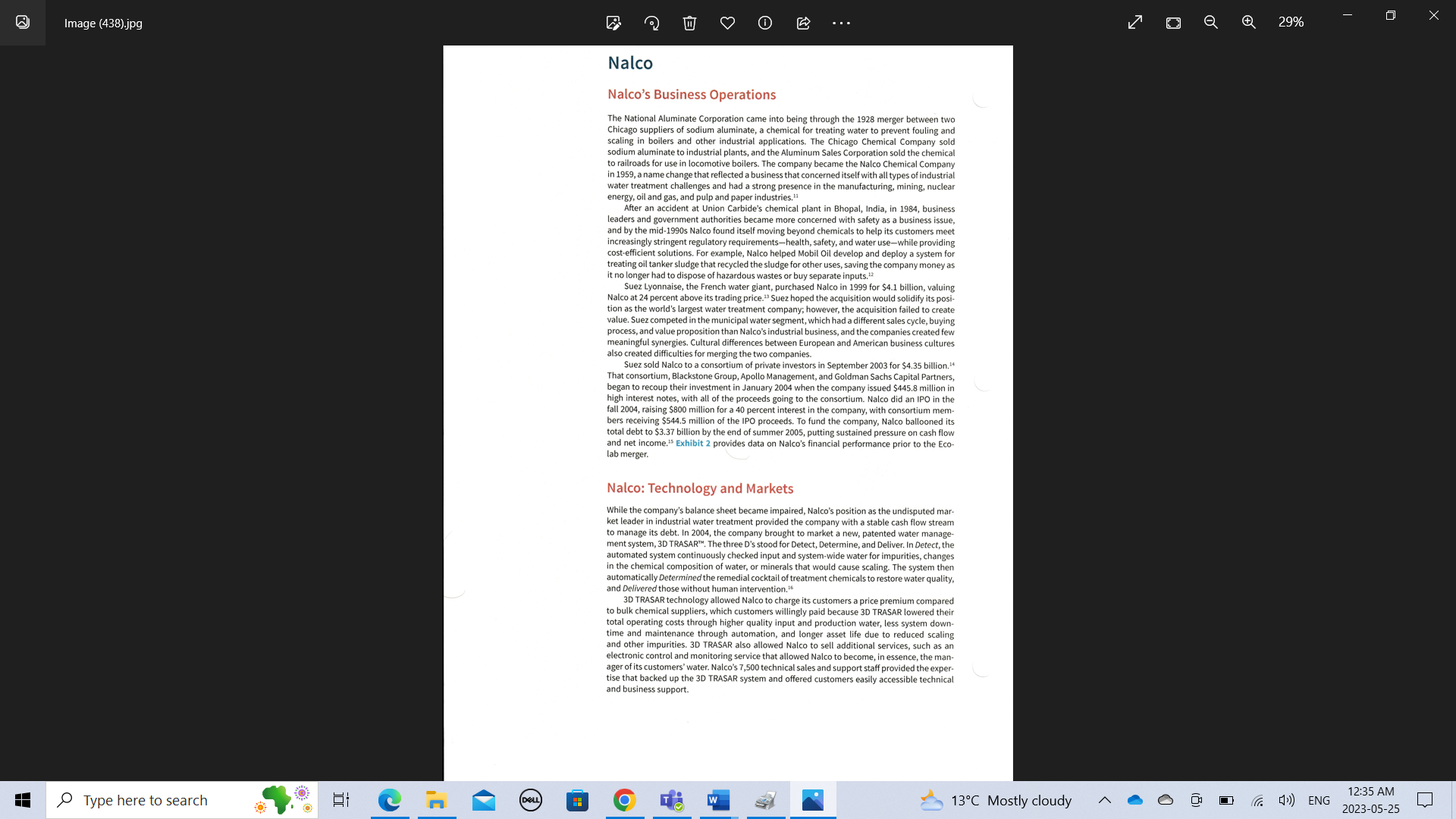
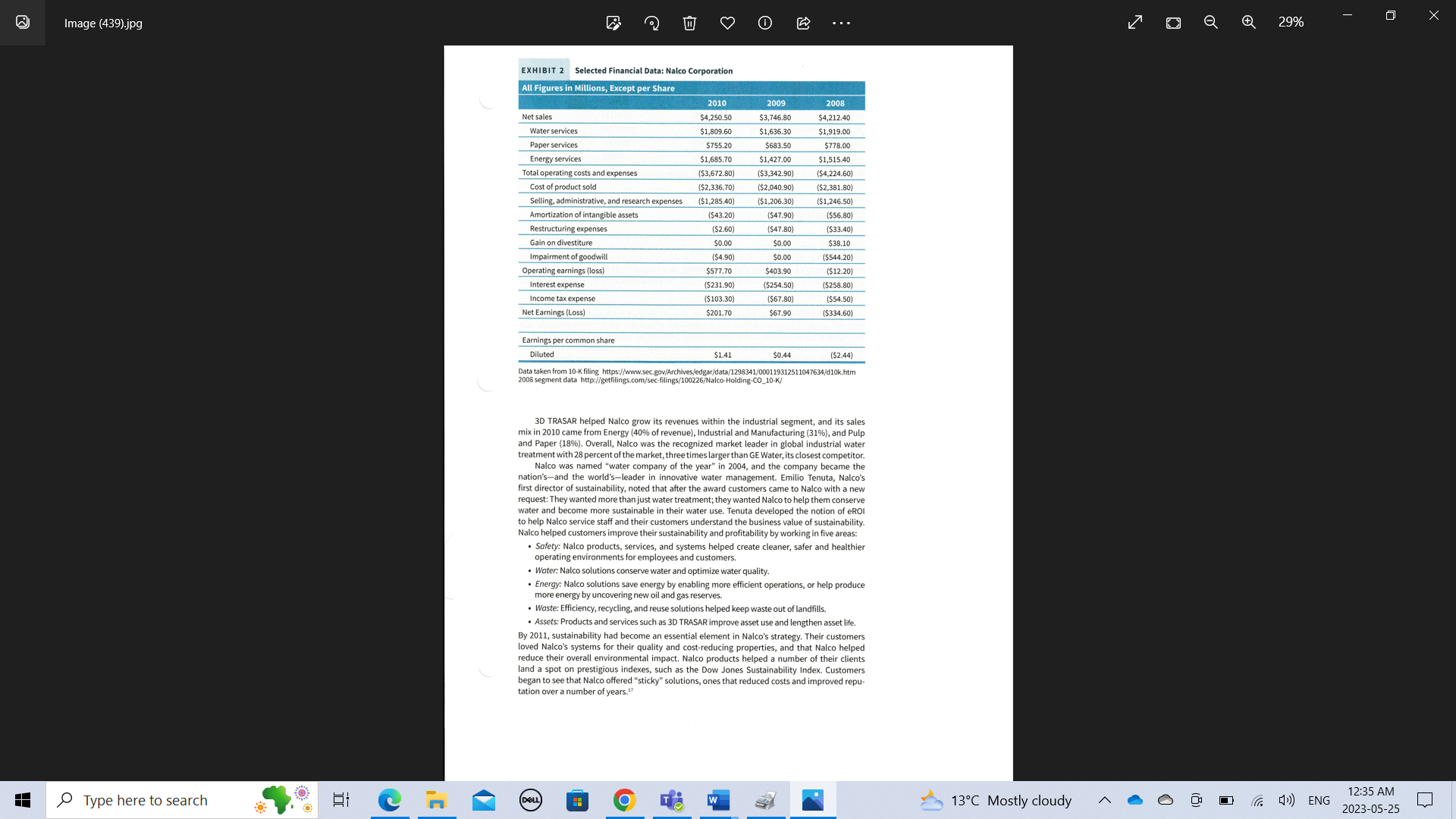
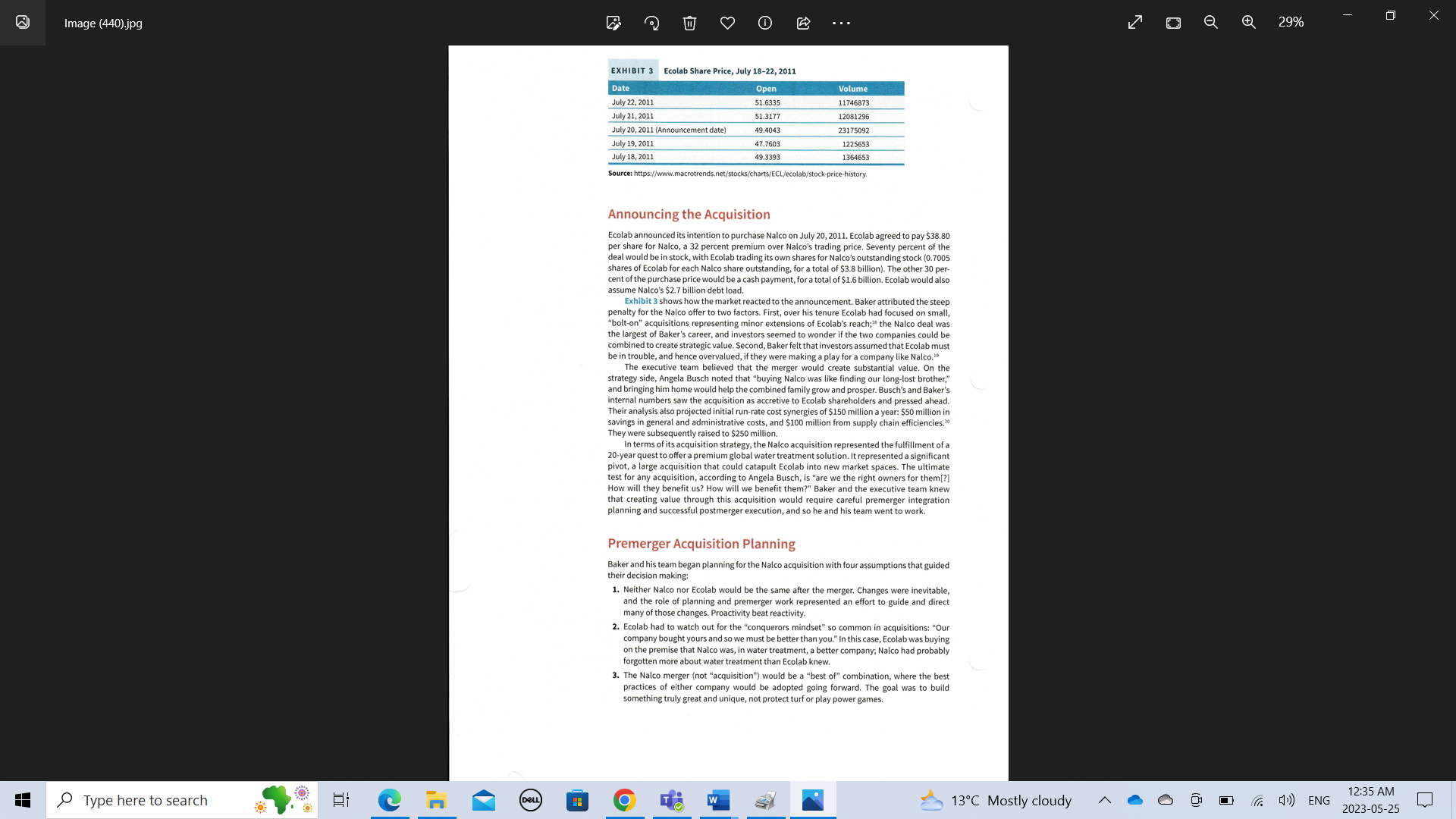
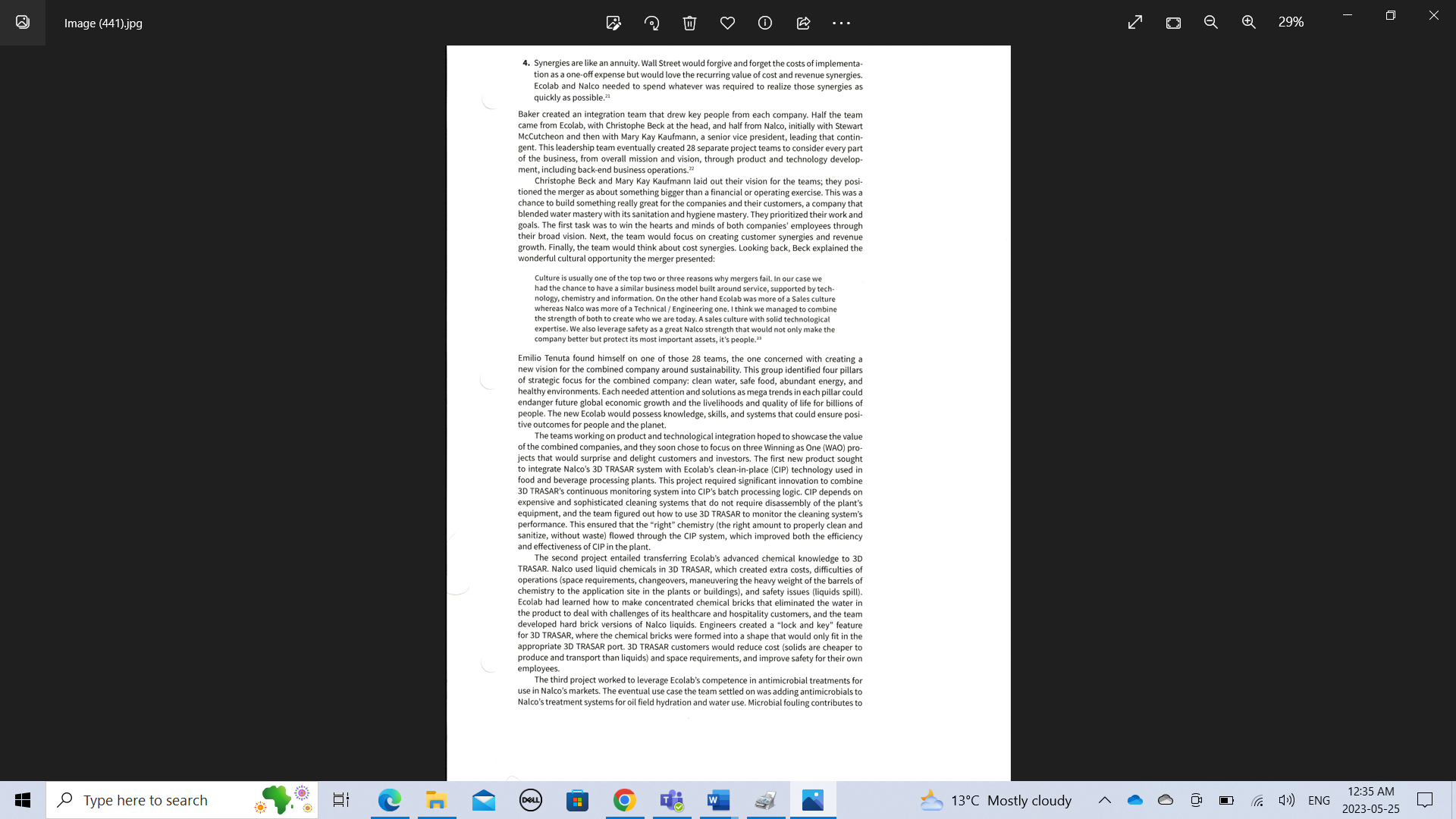
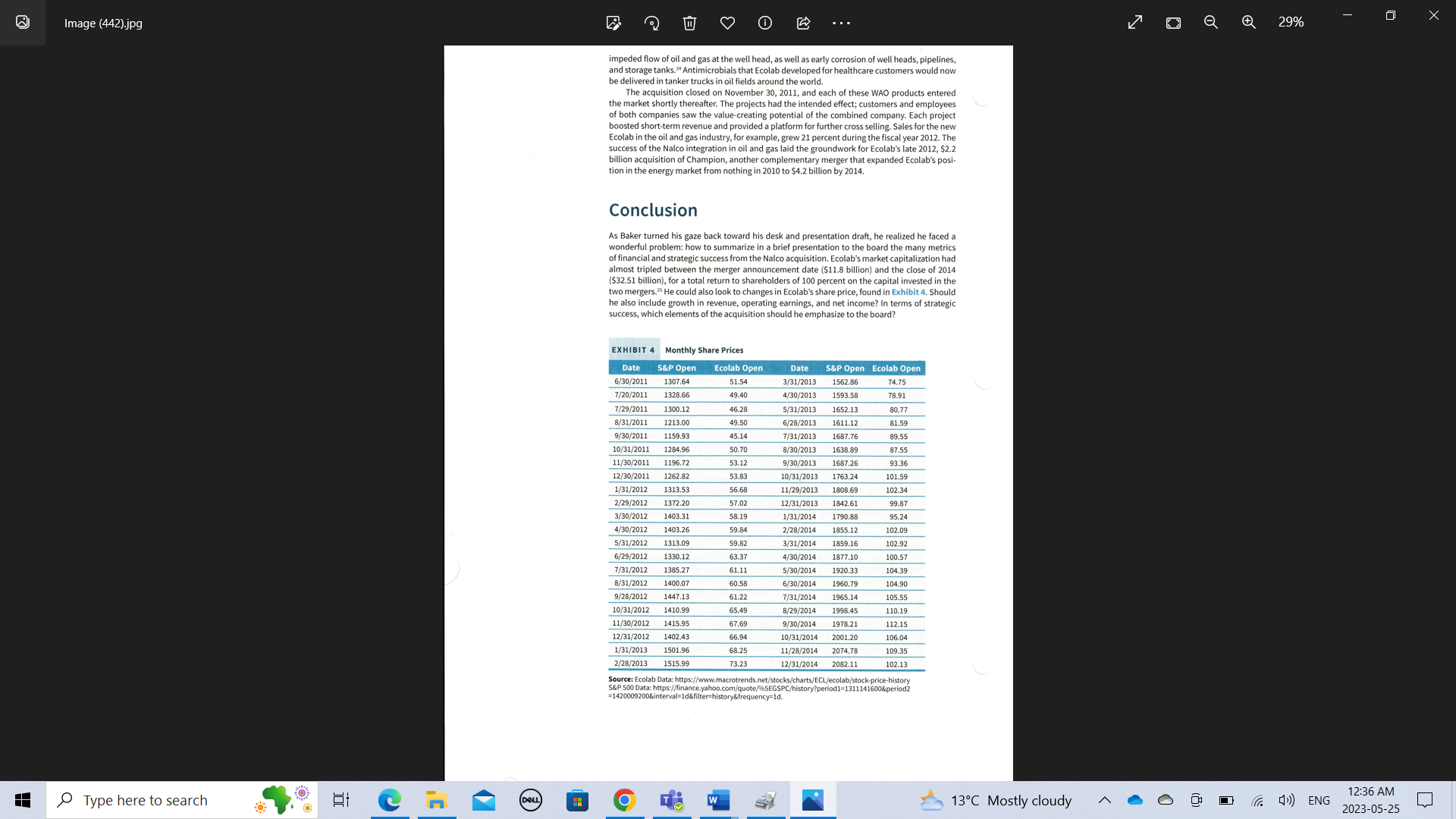
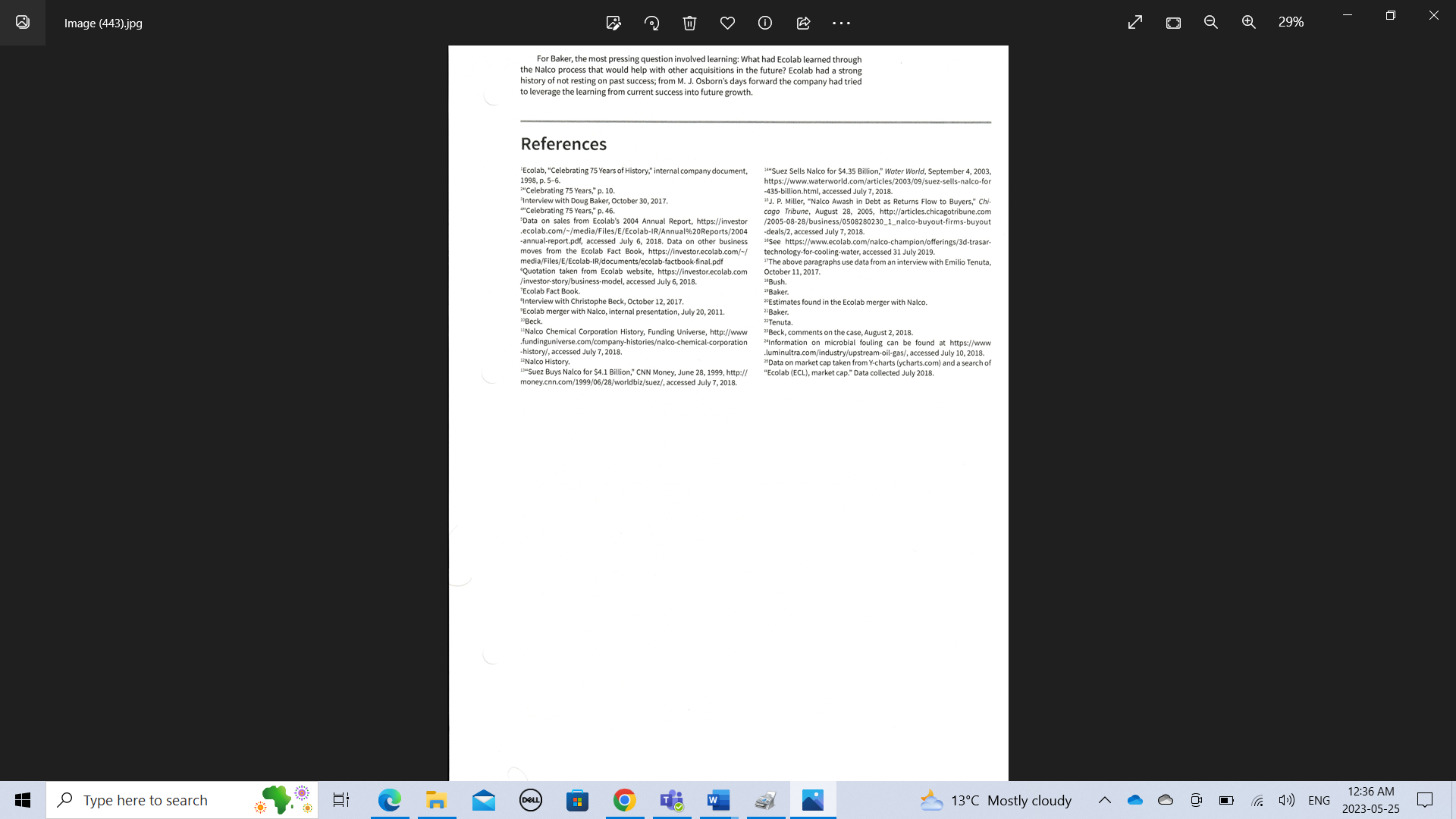
Ecolab and the NALCO Acquisition: Sustainable Advantage Through Shared Values
Assume the role of Doug Baker
What a wonderful problem. Prepare a draft presentation for Doug, dealing with the key questions he is considering.
In this assignment you may use case data and resources as presented in the case. In addition, you may find an internet search on effective presentations useful unless you are quite familiar with this type of communication in your work.
Doug Baker, CEO of Ecolab since 2004, turned his chair away from the desk and looked out over the St. Paul, Minnesota, skyline. In his 10 years at the helm of the Minnesota cleaning and sanitation firm, he had transitioned the company from a premier provider of cleaning, sanitation, and hygiene supplies to a leader in environmental sustainability. No action he took had been more significant than Ecolab's 2011 acquisition of Nalco, the nation's leading industrial water treatment and management firm. Baker's task on this spring afternoon in 2015 was to finalize his presentation for the upcoming board meeting. He needed to provide an assessment of the success of the Nalco acquisition. As he looked out on a beautiful Minnesota spring day, he pondered two questions: First, with a little more than three years since the deal closed, how successful had the acquisition really been, and second, what key learnings did he want his team to remember as they considered future acquisitions? Ecolab Historical Origins The Ecolab that Doug Baker headed looked remarkably different from, and yet very similar to, the company founded by Merritt J. (M. J.) Osborn in 1923. Osborn worked as a travelling salesman and noticed that the hotels he stayed in had to take rooms out of service for up to two weeks every time they cleaned the carpets. Osborn developed a carpet cleaner-Absorbit-that cleaned carpets in less time and with less water, meaning that rooms would be out of commission for a much shorter time. Although customers paid more for Absorbit, their total cost of cleaning-factoring in labor, water usage, and downtime-would be lower. 1 Osborn named his company Economics Laboratory (EL). "Economic" because it saved customers time, labor, and material costs, and "Laboratory" because the products were backed by laboratory research. In 1924, EL introduced Soilax, an easy-to-use and measure dishwashing detergent that set EL on the path of market leadership in the category. In 1928, Osborn rolled out a line of Soilax dispensers and other dishwashing equipment; EL became a provider of dishwashing solutions, not just soap. Over the next nine decades the company developed and followed a rather simple business model: identify a pressing customer problem in cleaning and sanitation, and develop a scientific solution that would save customers labor, maintenance, downtime, and equipment costs. Customers would pay a premium for the company's products because their lower total cost of using the EL system would more than make up for the costs of the products and regular on-site service provided by EL. EL hired technical people as field representatives, and a core tenet of Osborn's philosophy was that EL staff should "know more about the cleaning processes of that industry than anyone else, including the customer."2 Economics Laboratory sales and field service representatives would also be on call 24/7 to respond to customer challenges or problems with an EL system. This high level of customer service and support also justified the company's price premium. EL entered the dairy industry in the early 1950s. Poor cleaning practices and limited refrigeration capabilities meant that milk had a useful shelf life of only three days, leading to significant waste in the industry. EL bought a dairy equipment supplier, Klenzade Products, in 1961. Klenzade had pioneered a clean-in-place (CIP) system that allowed dairies to avoid the costly and time-consuming process of dismantling their entire production line to clean the system. EL combined its cleaning and sanitation expertise with Klenzade's core technology to roll out an improved CIP system for dairies, and eventually a variety of food and beverage customers. Doug Baker would note a half-century later that EL was the company that probably made the single biggest contribution to milk shelf life with its clean-in-place technology 3 EL continued to innovate and build out strong market positions in the consumer and institutional and light industrial ("I 1$1 ") cleaning and sanitation business: food and beverage production, food service (restaurants and cafeterias), healthcare, and hospitality. In 1986EL changed its name to Ecolab and began to shift its identity. The "eco" now stood for ecology and environment, while the "lab" continued the focus on science and technology." The following year the company sold its consumer dishwasher detergent business to focus solidly on serving its 1&1 businesses. Ecolab remained true to the original philosophy of M. J. Osborn through its emphasis on hiring and training technical experts who could help business customers solve problems and provide ongoing 24/7 service. Ecolab in the Twenty-First Century When Doug Baker assumed the role of president and CEO of Ecolab in 2004, the company had just broken $4 billion in sales, had created a division specifically to grow its healthcare business, and enjoyed a strong international presence. 5 Ecolab had rolled out a two-prong strategy a decade earlier: Circle the Customer, Circle the Globe. Circle the Customer described the process of finding an increasing number of customer-centric solutions for unique customer problems; Ecolab realized that "while we are only a very small part of our customers' cost to operate, because we ensure their ability to operate and protect their brand equity, we impact a large part of their P \& L." 16 Circle the Globe meant that Ecolab would follow its customers as they expanded in international markets and continue to provide trusted solutions and support. The company Baker inherited continued to evolve. In 2002 the company launched its EcoSure business, an assessment, evaluation, and training service that expanded the company's offerings from a focus on "end-of-use" cleanliness and sanitation to "beginning-ofuse" product safety and "in-use" process integrity. Ecolab won the 2006 Black Pearl Award for Corporate Excellence in Food Safety and Quality, presented by the International Association of Food Protection (IAFP). The award recognized Ecolab's contribution in enhancing food safety and employee awareness and knowledge through its efforts.? The award came at the same time as Ecolab began hearing from its customers that their businesses environments were shifting: Being a maker of high-quality and/or low-cost products and services was no longer enough; customers desired that these products and services be produced and delivered in a sustainable way that conserved, preserved, and reused natural resources wherever possible. As a steward of much of their customers' use of chemicals and solvents, and the water and waste that accompanied those products, Ecolab realized that its ability to help customers on their path to sustainability was both a business necessity and a tremendous opportunity for growth. The Move to Sustainability Christophe Beck, then executive vice president of the company's institutional businesses, explained that "the essence of sustainability is the fundamental proposition that you improve business perfor- mance at a lower cost as you reduce the use of natural resources. It's a win, win, win proposition."s The customer, Ecolab, and the environment would all win through sustainable solutions. As Ecolab's leaders looked toward the future as a company focused on sustainability, they instinctively looked to the past for guidance. Beck, Baker, and other members of the executive team realized that eight decades earlier, M. J. Osborn had created a company and a philosophy consistent with the modern notion of sustainability. Ecolab's focus on lowering a customer's total cost of operation built on a foundation of reducing the overall quantity of resources used, natural and human, that went into cleaning and sanitizing work, and minimizing the waste produced in the process. For its customers, sustainability may mean radical changes in the way they did business, but for Ecolab sustainability meant more of a change in messaging and tone since the DNA of sustainability had been hard wired in the company from its founding. As the company reframed the business conversation with its customers around sustainability, new opportunities for growth appeared. Sam Hsu directed Ecolab's operations in China from 2007 to 2012. When he arrived, customers, including Chinese government officials, viewed the company as a seller of commodities. Hsu began talking about Ecolab's capabilities in food safety and sustainability. The message resonated with officials in the midst of planning for the 2008 Olympic Games and the associated challenges of feeding visitors and athletes in a very high-profile setting. Ecolab staff worked with several government ministries to define new, and import existing, global standards for food safety and security. Ecolab became a central participant in a coalition of government officials, industry associations, public health interests, and media representatives. By 2010 , its focus on food safety and sustainability had transformed Ecolab from a seller of soap to a trusted advisor and business partner. The Nalco Acquisition Ecolab shifted its strategic position and messaging to focus on sustainability, but the company continued on its historical trajectory of creating innovative systems to solve customers' toughest problems. The company also enjoyed leadership positions in its core sanitation business with 35 percent of sales in food services and 25 percent in food and beverage production; the other 40 percent of Ecolab's sales came from its healthcare segment (15\%), hospitality (10%), and its other, smaller market segments (15\%)." Exhibit 1 displays Ecolab's selected income statement from 2008 to 2014. By early 2011, the company had developed a strong competency in antimicrobial products and delivery systems for infection control, a mission critical issue for its healthcare business, but also important to food and beverage and hospitality customers. Twenty years earlier, when talking with customers about their operating needs, Ecolab was told water treatment was a critical need for its institutional, food and beverage, and commercial laundry customers, all of whom had large water treatment needs. It was at that point the company realized the criticality of water and water management to sanitation, hygiene, and infection control for its customers and Ecolab set up to build a global capability in water treatment. The executive team realized that Ecolab now needed more competence and skill in water treatment and management; Ecolab wasn't, but needed to be, "masters of water." .10 The question was how to become a master of water, and Ecolab had two options: Build the capability internally or buy the competence through an acquisition. Ecolab attempted to build a water business through smaller acquisitions but had been unable to build the critical scale need to serve its global customers. Angela Busch, senior vice president for corporate development, explained that as the team investigated the water market, Nalco was the market leader and that "you can try to build Nalco 2 [which you can never do because they are the masters of water], or maybe you could buy them." After some discussion the team realized "you can't out Nalco Nalco," and Ecolab executives began to explore an acquisition. Annual %20 Reports/2010-annual-report.pdf Data for 2011-2012 taken from 2013 10-K, https://investor.ecolab.com/ /media/Files/E/Ecolab-IR/ Annual\%20Reports/2013-annual-report.pdf Data for 2013-2014 taken from 2014 10-K, https://investor.ecolab.com/-/media/Files/E/Ecolab-IR/ Annual\%20Reports/2014-annual-report.pdf Nalco's Business Operations The National Aluminate Corporation came into being through the 1928 merger between two Chicago suppliers of sodium aluminate, a chemical for treating water to prevent fouling and scaling in boilers and other industrial applications. The Chicago Chemical Company sold sodium aluminate to industrial plants, and the Aluminum Sales Corporation sold the chemical to railroads for use in locomotive boilers. The company became the Nalco Chemical Company in 1959, a name change that reflected a business that concerned itself with all types of industrial water treatment challenges and had a strong presence in the manufacturing, mining, nuclear energy, oil and gas, and pulp and paper industries. 11 After an accident at Union Carbide's chemical plant in Bhopal, India, in 1984, business leaders and government authorities became more concerned with safety as a business issue, and by the mid-1990s Nalco found itself moving beyond chemicals to help its customers meet increasingly stringent regulatory requirements-health, safety, and water use-while providing cost-efficient solutions. For example, Nalco helped Mobil Oil develop and deploy a system for treating oil tanker sludge that recycled the sludge for other uses, saving the company money as it no longer had to dispose of hazardous wastes or buy separate inputs. 12 Suez Lyonnaise, the French water giant, purchased Nalco in 1999 for $4.1 billion, valuing Nalco at 24 percent above its trading price. 13 Suez hoped the acquisition would solidify its position as the world's largest water treatment company; however, the acquisition failed to create value. Suez competed in the municipal water segment, which had a different sales cycle, buying process, and value proposition than Nalco's industrial business, and the companies created few meaningful synergies. Cultural differences between European and American business cultures also created difficulties for merging the two companies. Suez sold Nalco to a consortium of private investors in September 2003 for $4.35 billion. 14 That consortium, Blackstone Group, Apollo Management, and Goldman Sachs Capital Partners, began to recoup their investment in January 2004 when the company issued $445.8 million in high interest notes, with all of the proceeds going to the consortium. Nalco did an IPO in the fall 2004, raising $800 million for a 40 percent interest in the company, with consortium members receiving $544.5 million of the IPO proceeds. To fund the company, Nalco ballooned its total debt to $3.37 billion by the end of summer 2005 , putting sustained pressure on cash flow and net income.' Exhibit 2 provides data on Nalco's financial performance prior to the Ecolab merger. Nalco: Technology and Markets While the company's balance sheet became impaired, Nalco's position as the undisputed market leader in industrial water treatment provided the company with a stable cash flow stream to manage its debt. In 2004, the company brought to market a new, patented water management system, 3D TRASAR m.. The three D's stood for Detect, Determine, and Deliver. In Detect, the automated system continuously checked input and system-wide water for impurities, changes in the chemical composition of water, or minerals that would cause scaling. The system then automatically Determined the remedial cocktail of treatment chemicals to restore water quality, and Delivered those without human intervention. 16 3D TRASAR technology allowed Nalco to charge its customers a price premium compared to bulk chemical suppliers, which customers willingly paid because 3D TRASAR lowered their total operating costs through higher quality input and production water, less system downtime and maintenance through automation, and longer asset life due to reduced scaling and other impurities. 3D TRASAR also allowed Nalco to sell additional services, such as an electronic control and monitoring service that allowed Nalco to become, in essence, the manager of its customers' water. Nalco's 7,500 technical sales and support staff provided the expertise that backed up the 3D TRASAR system and offered customers easily accessible technical and business support. EXHIBIT 2 Selected Financial Data: Nalco Corporation 2008 segment data http://getfilings.com/sec-filings/100226/Nalco-Holding.CO_10-K/ 3D TRASAR helped Nalco grow its revenues within the industrial segment, and its sales mix in 2010 came from Energy (40\% of revenue), Industrial and Manufacturing (31\%), and Pulp and Paper (18\%). Overall, Nalco was the recognized market leader in global industrial water treatment with 28 percent of the market, three times larger than GE Water, its closest competitor. Nalco was named "water company of the year" in 2004, and the company became the nation's-and the world's-leader in innovative water management. Emilio Tenuta, Nalco's first director of sustainability, noted that after the award customers came to Nalco with a new request: They wanted more than just water treatment; they wanted Nalco to help them conserve water and become more sustainable in their water use. Tenuta developed the notion of eROI to help Nalco service staff and their customers understand the business value of sustainability. Nalco helped customers improve their sustainability and profitability by working in five areas: - Safety: Nalco products, services, and systems helped create cleaner, safer and healthier operating environments for employees and customers. - Water: Nalco solutions conserve water and optimize water quality. - Energy: Nalco solutions save energy by enabling more efficient operations, or help produce more energy by uncovering new oil and gas reserves. - Waste: Efficiency, recycling, and reuse solutions helped keep waste out of landfills. - Assets: Products and services such as 3D TRASAR improve asset use and lengthen asset life. By 2011, sustainability had become an essential element in Nalco's strategy. Their customers loved Nalco's systems for their quality and cost-reducing properties, and that Nalco helped reduce their overall environmental impact. Nalco products helped a number of their clients land a spot on prestigious indexes, such as the Dow Jones Sustainability Index. Customers began to see that Nalco offered "sticky" solutions, ones that reduced costs and improved reputation over a number of years. 17 EXHIBIT 3 Ecolab Share Price, July 18-22, 2011 Source: nttps://www.macrotrends, net/stocks/charts/ECL/ecolab/stock-price-history. Announcing the Acquisition Ecolab announced its intention to purchase Nalco on July 20, 2011. Ecolab agreed to pay $38.80 per share for Nalco, a 32 percent premium over Nalco's trading price. Seventy percent of the deal would be in stock, with Ecolab trading its own shares for Nalco's outstanding stock 0.7005 shares of Ecolab for each Nalco share outstanding, for a total of $3.8 billion). The other 30 percent of the purchase price would be a cash payment, for a total of $1.6 billion. Ecolab would also assume Nalco's $2.7 billion debt load. Exhibit 3 shows how the market reacted to the announcement. Baker attributed the steep penalty for the Nalco offer to two factors. First, over his tenure Ecolab had focused on small, "bolt-on" acquisitions representing minor extensions of Ecolab's reach; 18 the Nalco deal was the largest of Baker's career, and investors seemed to wonder if the two companies could be combined to create strategic value. Second, Baker felt that investors assumed that Ecolab must be in trouble, and hence overvalued, if they were making a play for a company like Nalco. 19 The executive team believed that the merger would create substantial value. On the strategy side, Angela Busch noted that "buying Nalco was like finding our long-lost brother," and bringing him home would help the combined family grow and prosper. Busch's and Baker's internal numbers saw the acquisition as accretive to Ecolab shareholders and pressed ahead. Their analysis also projected initial run-rate cost synergies of $150 million a year: $50 million in savings in general and administrative costs, and $100 million from supply chain efficiencies. 20 They were subsequently raised to $250 million. In terms of its acquisition strategy, the Nalco acquisition represented the fulfillment a 20 -year quest to offer a premium global water treatment solution. It represented a significant pivot, a large acquisition that could catapult Ecolab into new market spaces. The ultimate test for any acquisition, according to Angela Busch, is "are we the right owners for them[?] How will they benefit us? How will we benefit them?" Baker and the executive team knew that creating value through this acquisition would require careful premerger integration planning and successful postmerger execution, and so he and his team went to work. Premerger Acquisition Planning Baker and his team began planning for the Nalco acquisition with four assumptions that guided their decision making: 1. Neither Nalco nor Ecolab would be the same after the merger. Changes were inevitable, and the role of planning and premerger work represented an effort to guide and direct many of those changes. Proactivity beat reactivity. 2. Ecolab had to watch out for the "conquerors mindset" so common in acquisitions: "Our company bought yours and so we must be better than you." In this case, Ecolab was buying on the premise that Nalco was, in water treatment, a better company; Nalco had probably forgotten more about water treatment than Ecolab knew. 3. The Nalco merger (not "acquisition") would be a "best of" combination, where the best practices of either company would be adopted going forward. The goal was to build something truly great and unique, not protect turf or play power games. 4. Synergies are like an annuity. Wall Street would forgive and forget the costs of implementation as a one-off expense but would love the recurring value of cost and revenue synergies. Ecolab and Nalco needed to spend whatever was required to realize those synergies as quickly as possible., 11 Baker created an integration team that drew key people from each company. Half the team came from Ecolab, with Christophe Beck at the head, and half from Nalco, initially with Stewart McCutcheon and then with Mary Kay Kaufmann, a senior vice president, leading that contingent. This leadership team eventually created 28 separate project teams to consider every part of the business, from overall mission and vision, through product and technology development, including back-end business operations. 2 Christophe Beck and Mary Kay Kaufmann laid out their vision for the teams; they positioned the merger as about something bigger than a financial or operating exercise. This was a chance to build something really great for the companies and their customers, a company that blended water mastery with its sanitation and hygiene mastery. They prioritized their work and goals. The first task was to win the hearts and minds of both companies' employees through their broad vision. Next, the team would focus on creating customer synergies and revenue growth. Finally, the team would think about cost synergies. Looking back, Beck explained the wonderful cultural opportunity the merger presented: Culture is usually one of the top two or three reasons why mergers fail. In our case we had the chance to have a similar business model built around service, supported by technology, chemistry and information. On the other hand Ecolab was more of a Sales culture whereas Nalco was more of a Technical/Engineering one. I think we managed to combine the strength of both to create who we are today. A sales culture with solid technological expertise. We also leverage safety as a great Nalco strength that would not only make the company better but protect its most important assets, it's people. 23 Emilio Tenuta found himself on one of those 28 teams, the one concerned with creating a new vision for the combined company around sustainability. This group identified four pillars of strategic focus for the combined company: clean water, safe food, abundant energy, and healthy environments. Each needed attention and solutions as mega trends in each pillar could endanger future global economic growth and the livelihoods and quality of life for billions of people. The new Ecolab would possess knowledge, skills, and systems that could ensure positive outcomes for people and the planet. The teams working on product and technological integration hoped to showcase the value of the combined companies, and they soon chose to focus on three Winning as One (WAO) projects that would surprise and delight customers and investors. The first new product sought to integrate Nalco's 3D TRASAR system with Ecolab's clean-in-place (CIP) technology used in food and beverage processing plants. This project required significant innovation to combine 3D TRASAR's continuous monitoring system into CIP's batch processing logic. CIP depends on expensive and sophisticated cleaning systems that do not require disassembly of the plant's equipment, and the team figured out how to use 3D TRASAR to monitor the cleaning system's performance. This ensured that the "right" chemistry (the right amount to properly clean and sanitize, without waste) flowed through the CIP system, which improved both the efficiency and effectiveness of CIP in the plant. The second project entailed transferring Ecolab's advanced chemical knowledge to 3D TRASAR. Nalco used liquid chemicals in 3D TRASAR, which created extra costs, difficulties of operations (space requirements, changeovers, maneuvering the heavy weight of the barrels of chemistry to the application site in the plants or buildings), and safety issues (liquids spill). Ecolab had learned how to make concentrated chemical bricks that eliminated the water in the product to deal with challenges of its healthcare and hospitality customers, and the team developed hard brick versions of Nalco liquids. Engineers created a "lock and key" feature for 3D TRASAR, where the chemical bricks were formed into a shape that would only fit in the appropriate 3D TRASAR port. 3D TRASAR customers would reduce cost (solids are cheaper to produce and transport than liquids) and space requirements, and improve safety for their own employees. The third project worked to leverage Ecolab's competence in antimicrobial treatments for use in Nalco's markets. The eventual use case the team settled on was adding antimicrobials to Nalco's treatment systems for oil field hydration and water use. Microbial fouling contributes to impeded flow of oil and gas at the well head, as well as early corrosion of well heads, pipelines, and storage tanks. 24 Antimicrobials that Ecolab developed for healthcare customers would now be delivered in tanker trucks in oil fields around the world. The acquisition closed on November 30, 2011, and each of these WAO products entered the market shortly thereafter. The projects had the intended effect; customers and employees of both companies saw the value-creating potential of the combined company. Each project boosted short-term revenue and provided a platform for further cross selling. Sales for the new Ecolab in the oil and gas industry, for example, grew 21 percent during the fiscal year 2012. The success of the Nalco integration in oil and gas laid the groundwork for Ecolab's late 2012, \$2.2 billion acquisition of Champion, another complementary merger that expanded Ecolab's position in the energy market from nothing in 2010 to $4.2 billion by 2014. Conclusion As Baker turned his gaze back toward his desk and presentation draft, he realized he faced a wonderful problem: how to summarize in a brief presentation to the board the many metrics of financial and strategic success from the Nalco acquisition. Ecolab's market capitalization had almost tripled between the merger announcement date ( $11.8 billion) and the close of 2014 ( $32.51 bilion), for a total return to shareholders of 100 percent on the capital invested in the two mergers. 3 He could also look to changes in Ecolab's share price, found in Exhibit 4. Should he also include growth in revenue, operating earnings, and net income? In terms of strategic success, which elements of the acquisition should he emphasize to the board? EXHIBIT A Mnnthlu Share Drirpe Source: Ecolab Data: https://www.macrotrends.net/stocks/charts/ECL/ecolab/stock-price-history S\&P 500 Data: https://finance.yahoo.com/quote/\%5EGSPC/history?period1=1311141600\&period2 =1420009200 \&interval"1d\&filter=history\&frequency=1d. For Baker, the most pressing question involved learning: What had Ecolab learned through the Nalco process that would help with other acquisitions in the future? Ecolab had a strong history of not resting on past success; from M. J. Osborn's days forward the company had tried to leverage the learning from current success into future growth. References 'Ecolab, "Celebrating 75 Years of History," internal company document, 1998, p. 5-6. 2"Celebrating 75 Years," p. 10. Interview with Doug Baker, October 30, 2017. "Celebrating 75 Years," p. 46. 'Data on sales from Ecolab's 2004 Annual Report, https://investor .ecolab.com/ /media/Files/E/Ecolab-IR/Annual\%20Reports/2004 -annual-report.pdf, accessed July 6, 2018. Data on other business moves from the Ecolab Fact Book, https://investor.ecolab.com/ / media/Files/E/Ecolab-IR/documents/ecolab-factbook-final.pdf "Quotation taken from Ecolab website, https://investor.ecolab.com /investor-story/business-model, accessed July 6, 2018. 'Ecolab Fact Book. "Interview with Christophe Beck, October 12, 2017. "Ecolab merger with Nalco, internal presentation, July 20, 2011. theck. Bechat "Nalco Chemical Corporation History, Funding Universe, http://www fundinguniverse.com/company-historiesalco-chemical-corporation -history/, accessed July 7, 2018. Nalco History. "Suez Buys Nalco for \$4.1 Billion," CNN Money, June 28, 1999, http:// money.cnn.com/1999/06/28/worldbiz/suez/, accessed July 7, 2018. 3an "Suez Sells Nalco for $4.35 Billion," Water World, September 4, 2003, https://www.waterworld.com/articles/2003/09/suez-sells-nalco-for -435-billion.html, accessed July 7, 2018. ". P. Miller, "Nalco Awash in Debt as Returns Flow to Buyers," Chicogo Tribune, August 28, 2005, http://articles.chicagotribune.com /2005-08-28/business/0508280230_1_nalco-buyout-firms-buyout -deals/2, accessed July 7,2018. utSee https://www.ecolab.comalco-champion/offerings/3d-trasartechnology-for-cooling-water, accessed 31 July 2019 . 17 The above paragraphs use data from an interview with Emilio Tenuta, October 11,2017. "Bush. "Baker. "Estimates found in the Ecolab merger with Nalco. aiaker. 22 Tenuta. "Beck, comments on the case, August 2, 2018. 24 Information on microbial fouling can be found at https://www .luminultra.com/industry/upstream-oil-gas/, accessed July 10, 2018. 2 Data on market cap taken from Y-charts (ycharts.com) and a search of "Ecolab (ECL), market cap." Data collected July 2018Step by Step Solution
There are 3 Steps involved in it
Step: 1

Get Instant Access to Expert-Tailored Solutions
See step-by-step solutions with expert insights and AI powered tools for academic success
Step: 2

Step: 3

Ace Your Homework with AI
Get the answers you need in no time with our AI-driven, step-by-step assistance
Get Started


